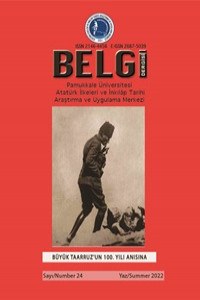DİYARBAKIR VİLAYETİ’NDE ÂSÂR-I ATÎKA BİLİNCİNİN GELİŞİMİ: MÜZE-İ HÜMÂYÛN FAHRÎ MEMURU NATIK EFENDİ VE FAALİYETLERİ
Abstract
Osmanlı Devleti kültürel yönden farklı birçok medeniyete ev sahipliği yapmış ve hem nitelik hem de nicelik bağlamında zengin topraklar üzerinde hakimiyet sürdürmüştür. Osmanlı Devleti’nde âsâr-ı atîka konusunda başlangıçta kanunname ve fıkıh usullerine göre bir yol izlenmiş olsa da zamanla uygulanan nizamnameler sonucunda ilerleme sağlanmış ve müzecilik ile eski eser bilincinin gelişimine katkı sağlanmıştır. Modern anlamda müzeciliğin temeli Sultan Abdülmecit döneminde ve Fethi Ahmet Paşa’nın çabalarıyla atılmıştır. Bununla birlikte II. Abdülhamit dönemi ve Osman Hamdi Bey’in Müze-i Hümayun müdürlüğü sürecinde ise köklü hukuksal ve kurumsal düzenlemeler gerçekleştirilmiştir. Bunun üzerine Osmanlı merkezinde oluşan âsâr-ı atîka bilinci kısa bir sürede taşraya yansımıştır. Bu çalışma mahallî görevlilerin yanı sıra özellikle Diyarbakır Müze-i Hümayun Fahri Memuru Natık Efendi’nin tutumu bağlamında Osmanlı taşrasında eski eser bilincinin gelişimini tespit etmek amacıyla kaleme alınmıştır. Ayrıca XIX. yüzyılın son ve XX. yüzyılın ilk yıllarını kapsamaktadır. Söz konusu süreçte ve belirtilen maksat doğrultusunda Diyarbakır Vilayeti’nde âsâr-ı atîka bilincinin gelişimi konusunda genel bir değerlendirme yapılmış ve Diyarbakır Müze-i Hümayun Fahri Memuru Natık Efendi’nin faaliyetleri de derinlemesine irdelenmiştir. Buna göre; Diyarbakır’da âsâr-ı atîka bilincinin nasıl ortaya çıktığı, merkezde uygulanan eski eser politikalarının Diyarbakır’a nasıl yansıdığı, hangi süreçlerden geçildiği ve nasıl bir yol izlendiği, Natık Efendi’nin eski eser alanındaki konumu ve Diyarbakır’daki faaliyetleri ele alınmıştır. Bilahare Diyarbakır’dan Müze-i Hümayun’a hangi tür eserlerin nakledildiği ve bunların da nasıl korunduğuna yönelik çabalar değerlendirilmiştir. Söz konusu sorulara cevap bulabilmek için Osmanlı Devleti’nin o dönem içerisinde tutmuş olduğu ve bugün Osmanlı arşivlerinde bulunan belgeler ile dönemin basın hayatı ve salnameler üzerinden bu süreç izlenmiştir. Bununla birlikte söz konusu dönemde ve sonraki dönemlerde kaleme alınmış eserlere de başvurulmuştur.
References
- Arşiv Kaynakları (BOA) Gazeteler Salnameler Yayımlanmış Vesikalar Araştırma ve İnceleme Eserler
Development of Awareness on Cultural Herıtage in Dıyarbakır Provınce: Muze-i Humayun Honorary Offıcer Natık Efendy and Its Actıvıtıes
Abstract
The Ottoman Empire hosted many culturally different civilizations and maintained dominance over rich lands in terms of both quality and quantity. In the field of cultural heritage, although a path was followed in accordance with the methods of law and fiqh at the beginning, progress was made in the field of regulations over time, and a contribution was made to the development of the awareness of museology and antiquities. The foundation of modern museology in the Ottoman Empire was laid during the reign of Sultan Abdülmecit and with the efforts of Fethi Ahmet Pasha. However, In the period of II. Abdülhamit and Osman Hamdi Bey’s directorship of the museum, deep-rooted legal and institutional arrangements were made. There upon, the cultural heritage consciousness that emerged in the Ottoman center was reflected in the countryside in a short time. This study was written in order to determine the development of antiquities consciousness in the Ottoman provinces, especially in the context of the attitude Honorary Officer of the Diyarbakir Müze-i Hümayun (imperial museum) of Natik Efendy, as well as the local officials. Also, in the XIX. the end of the century and the XX. covers the first years of the century. In the said process and in line with the stated purpose, a general evaluation was made on the development of the cultural heritage consciousness in Diyarbakir Province and the activities of Diyarbakir Müze-i Hümayun Honorary Officer Natik Efendy were also examined in depth. According to this; How the cultural heritage consciousness emerged in Diyarbakir, how the antiquities policies implemented in the center reflected on Diyarbakir, what processes were passed and what kind of path was followed, the position of Natik Efendy in the field of antiquities and his activities in Diyarbakir were discussed. Subsequently, the efforts to determine what kinds of artifacts were transferred from Diyarbakir to the Müze-i Hümayun and how they were preserved were evaluated. In order to find answers to these questions, this process has been followed through the documents that the Ottoman Empire kept during that period and which are in the Ottoman archives today, as well as the press life of the period and the annuals. In addition, the works written in the mentioned period and in the following periods were also consulted.
References
- Arşiv Kaynakları (BOA) Gazeteler Salnameler Yayımlanmış Vesikalar Araştırma ve İnceleme Eserler
Details
| Primary Language | Turkish |
|---|---|
| Journal Section | Research Article |
| Authors | |
| Publication Date | July 1, 2022 |
| Submission Date | April 21, 2022 |
| Acceptance Date | June 13, 2022 |
| Published in Issue | Year 2022 Issue: 24 |


